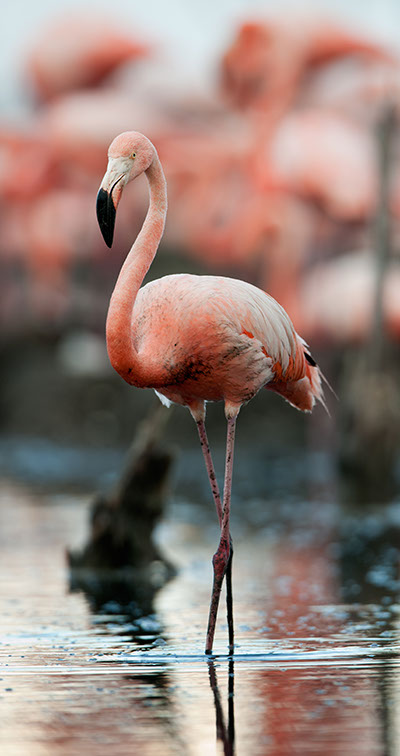SciGen Teacher Dashboard
Unit L2
Environmental Impact
 The Great Rift Valley in east Africa is home to many saltwater lakes and also the famously pink Lesser Flamingo. But there is now only one lake, Lake Natron in Tanzania, that is a suitable breeding ground for this species.
The Great Rift Valley in east Africa is home to many saltwater lakes and also the famously pink Lesser Flamingo. But there is now only one lake, Lake Natron in Tanzania, that is a suitable breeding ground for this species.
In this unit, students explore the difficult choices communities face as they decide whether to build a factory at Lake Natron. A similar factory was built years ago at nearby Lake Magadi in Kenya and students learn about the effect it had on the flamingos at that salt lake.
Activities
 Scene: Flamingos in a Fix
Scene: Flamingos in a Fix
In this Readers’ Theater script, a family of Lesser Flamingos is flying to their breeding ground at Lake Natron in Tanzania. Five characters—Flora, Flavio, Flynn, Flo, Uncle Willy—discuss the history of their use of different lakes in The Great Rift Valley in East Africa. The focus words are introduced: habitat, condition, source, destruction, extinction, optimal, threat, impact, and preservation.
Duration: Approximately 50 minutes
 Interactive Video: Optimal Conditions
Interactive Video: Optimal Conditions
Using the technique of “scrubbing” video, students move back and forth within the video while the file is still open. This is a common technique used by scientists in fields from psychology to biology to physics—any domain where raw, unedited video might be used to capture data. Of course, scrubbing is used in other fields, such as media production.
Duration: Approximately 50 minutes
 Demo: Killer Crystals
Demo: Killer Crystals
After examining photos of a young flamingo chick and comparing them to full-grown lesser flamingos, students model the threat to the young chicks of a flamingo population. They observe the results of crystallization through empirical observation of this demo.
Duration: Approximately 35 minutes plus many hours to see results
 Interactive Lesson: Comparing Two Lakes
Interactive Lesson: Comparing Two Lakes
After a brief discussion and locating two East African lakes geographically, students watch a movie and then process what they've learned from it using a Venn diagram. They then connect the issue of the flamingo habitat to the use of recyclable glass.
Duration: Approximately 90 minutes
 Interactive Reading: Dustville Dilemmas
Interactive Reading: Dustville Dilemmas
Students read a choose-your-own-adventure story and make decisions as the mayor of a fictional town in the desert Southwest.
Duration: Approximately 90 minutes
 Conversation: Deciding about Lake Natron
Conversation: Deciding about Lake Natron
After reviewing some simple ground rules for a class debate and considering two perspectives on the construction of a soda ash factory on the shores of Lake Natron, students engage in a class debate.
Duration: Approximately 120 minutes
Teacher Tune-ups
- Why are some lakes salty? And why are some lakes alkaline?
- What is involved in studying the environmental impact of a construction project?
Student View of Visuals and Activities
Some teachers prefer to have students view the slides and other visual assets in this unit directly instead of projecting them in class. Below is a web page to share with students with links to some of same items that are within in the teacher lesson plans, but without the explanatory text for the teacher.
Unit L2 Focus Words
habitat
noun – the natural home or environment of an animal, plant, or other organism
Why do you think animals prefer certain habitats?
condition
noun – the state of something, especially having to do with appearance or quality
What kinds of conditions are best for flamingos to breed?
source
noun – 1. someone or something that provides what is wanted or needed
2. the place of origin of a stream or river
What is your favorite source for information? Explain.
destruction
noun – the process of ruining something beyond repair
Can you think of a time when you saw destruction in your city or town? What happened?
extinction
noun – the state or process of a species, family, or larger group ceasing to exist
What are some reasons why a species might face extinction?
optimal
adjective – best or most favorable
What do you think the optimal time of year is for playing outside?
threat
noun – something that is likely to cause danger or harm
What types of environmental threats might endanger animals?
impact
noun – 1. the act or force of one thing hitting another
2. the effect or influence of one thing on another
Heavy rains had an impact on the flamingos in the Science Scene. What other animals could rain have an impact on?
preservation
noun – the act of maintaining something in its original or existing state
When might preservation be a good use of government money?
BETA Version - Please send comments and corrections to info@serpinstitute.org